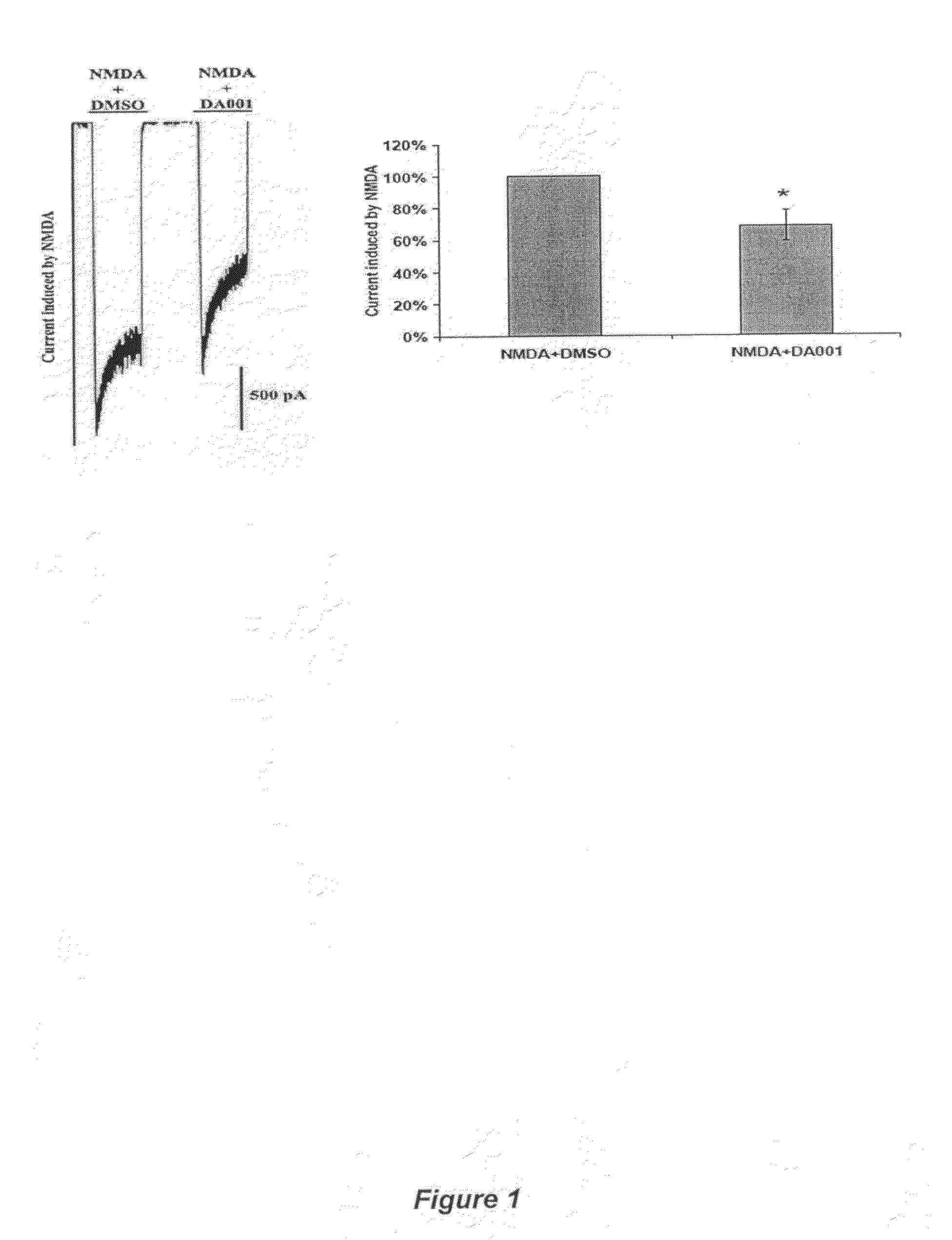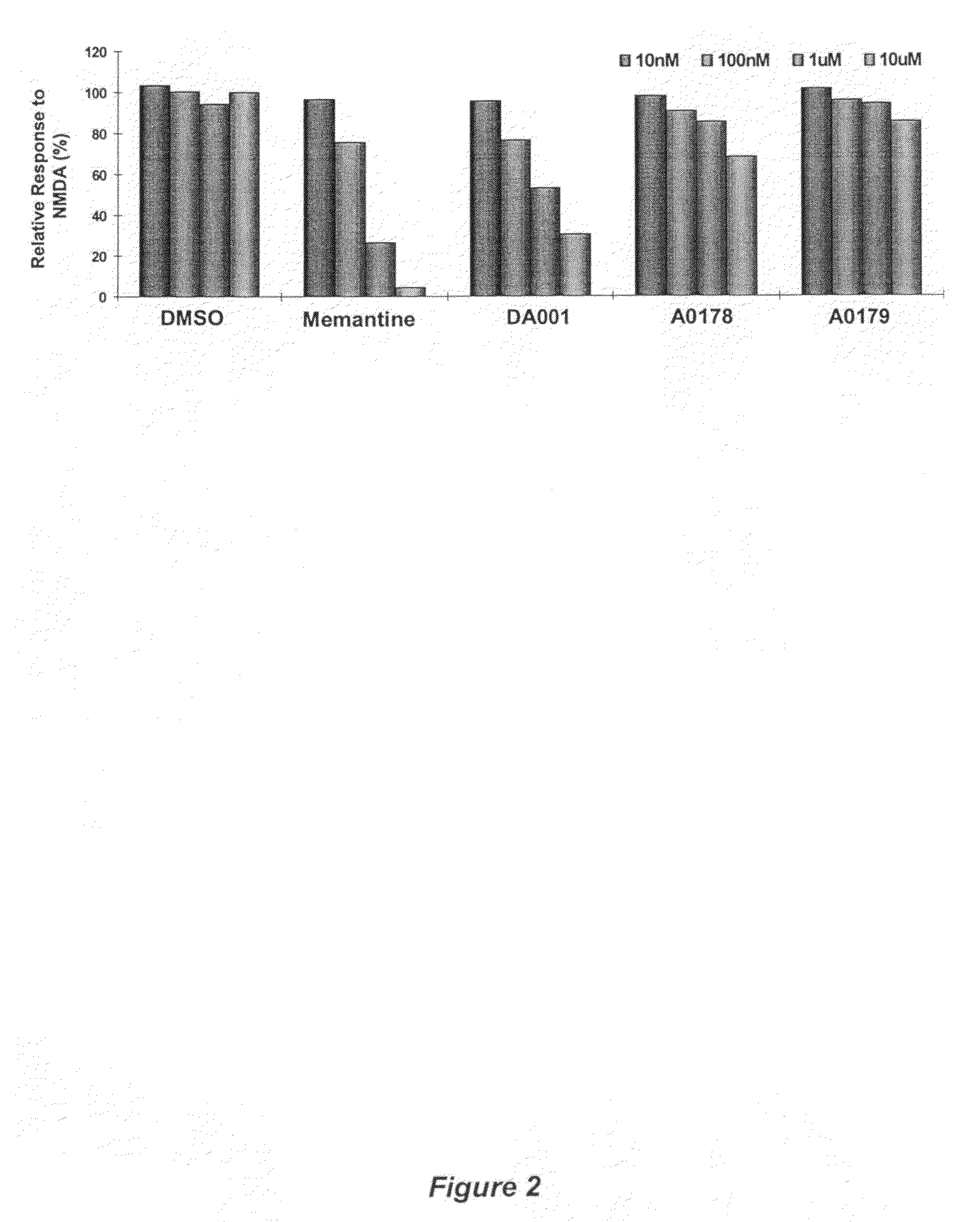Receptor modulators exhibiting neuroprotective and memory enhancing activities
a technology of receptor modulators and neuroprotective activities, applied in the direction of biocide, cardiovascular disorders, drug compositions, etc., can solve the problems of neuronal cell death, excitotoxicity, association cell damage and death, etc., to prevent neuronal damage, inhibit the activity of nmda and/or mc receptors, and enhance brain cognitive function
- Summary
- Abstract
- Description
- Claims
- Application Information
AI Technical Summary
Benefits of technology
Problems solved by technology
Method used
Image
Examples
example 1
Synthesis of 3,23-Dihydroxy-20(29)-lupen-28-oic acid (DA002)
[0129]
[0130]To a solution of HCl methanol reagent 10 (10 mL) was added Pulchinenoside A (DA001, 100 mg) and the resulting mixture was stirred at 35° C. for 4 days. After pouring into water (10 ml), the mixture was extracted with chloroform (3×50 ml). The combined organic layer was washed with H2O (1×10 ml), brine (1×10 ml), dried over sodium sulfate and concentrated under vacuum. The resulting residue was purified by column chromatography on silica gel using CH2Cl2-MeOH (v / v, 30:1) to yield the desired product as a white solid with 85% yield.
example 2
Synthesis 3,23-Dihydroxy-20(29)-lupen-28-oic acid, methyl ester (DA003)
[0131]To a solution of 3,23-dihydroxy-20(29)-lupen-28-oic acid (10 mg, 0.021 mmol) in THF (2 mL) was added K2CO3 (4.4 mg, 0.032 mmol) and MeI (1.7 μL, 0.032 mmol). After stirring at room temperature for 12 h, the reaction was quenched by adding 20% Na2S2O3 (0.5 ml) and saturated NaHCO3 (0.5 ml). The mixture was extracted with ethyl acetate (3×10 ml). The combined organic layer was washed with H2O (1×2 ml), brine (1×2 ml), dried over sodium sulfate and concentrated under vacuum. The resulting residue was purified by column chromatography on silica gel using CH2Cl2-MeOH (v / v, 30:1) to yield the desired product as a white solid with 95% yield. 1H NMR (300 MHz, CDCl3, δ ppm): 4.73 (s, 1H), 4.59 (s, 1H), 3.71 (d, J=10.5 Hz, 1H), 3.66 (s, 3H, OCH3), 5.59-3.64 (m, 1H), 3.41 (d, J=10.5 Hz, 1H), 2.98-3.00 (m, 1H), 2.19-2.24 (m, 2H), 1.79-1.90 (m, 2H), 1.70 (s, 3H, CH3), 1.00-1.68 (m, 22H), 0.89-0.99 (m, 12H, 4×CH3).
example 3
Synthesis of 3,23-Dihydroxy-20(29)-lupen-28-oic acid, ethyl ester (DA004)
[0132]To a solution of 3,23-dihydroxy-20(29)-lupen-28-oic acid (20 mg, 0.043 mmol) in DMF (2 ml) was added K2CO3 (9 mg), and EtI (5.2 μl) at r.t., and the resulting mixture was stirred at 40° C. overnight. After the reaction was quenched with 20% Na2S2O3 (0.5 ml) and saturated NaHCO3 (0.5 ml), the mixture was extracted with ethyl acetate (3×15 ml). The combined organic layer was washed with H2O (6×2 ml), brine (1×2 ml), dried over sodium sulfate and concentrated under vacuum. The resulting residue was purified by column chromatography on silica gel using CH2Cl2-MeOH (v / v, 30:1) to yield compound DA004 as a white solid with 90% yield. 1H NMR (300 MHz, CDCl3, δ ppm): 4.72 (s, 1H), 4.59 (s, 1H), 4.13 (q, J=6.3 Hz, 2H), 3.70 (d, J=10.5 Hz, 1H), 3.60 (t, J=7.5 Hz, 1H), 3.40 (d, J=10.5 Hz, 1H), 2.95-3.00 (m, 1H), 2.20-2.24 (m, 2H), 1.70-1.90 (m, 2H), 0.99-1.67 (m, 28H), 0.85-0.95 (m, 12H, 4×CH3).
PUM
| Property | Measurement | Unit |
|---|---|---|
| pH | aaaaa | aaaaa |
| temperature | aaaaa | aaaaa |
| pH | aaaaa | aaaaa |
Abstract
Description
Claims
Application Information
 Login to View More
Login to View More - R&D
- Intellectual Property
- Life Sciences
- Materials
- Tech Scout
- Unparalleled Data Quality
- Higher Quality Content
- 60% Fewer Hallucinations
Browse by: Latest US Patents, China's latest patents, Technical Efficacy Thesaurus, Application Domain, Technology Topic, Popular Technical Reports.
© 2025 PatSnap. All rights reserved.Legal|Privacy policy|Modern Slavery Act Transparency Statement|Sitemap|About US| Contact US: help@patsnap.com



